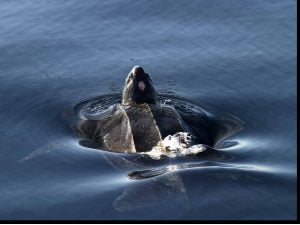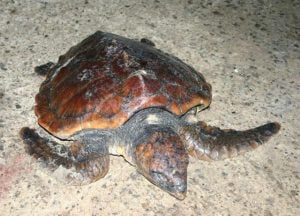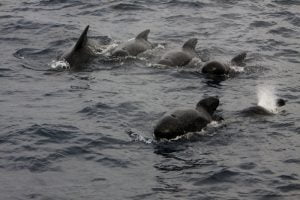As 2015 came to an end, it made the national news that loggerhead turtles were being washed ashore along the south coast of Ireland. All were in a hypothermic condition, having been driven too far north by the prevailing weather of the last couple of months, from the much warmer areas of the Atlantic that they normally inhabit. The news report stated correctly that loggerheads are not often found in Irish waters, with only around 40 recorded since 1960.
This report reminded me of an encounter I had with a huge loggerhead, years ago, which goes as follows….
In the very fine summer of 1975, one of the best ever recorded, I was fishing for a living in a 20 foot timber yawl. After years of skippering other peoples’ boats, it was the first boat I was the owner of. I bought her new in the spring of that year, just the bare hull, and fitted it out enough to set about making a living from it. The hull was constructed in West Cork, carvel built on good strong frames, of classic Irish design. Powered up with a 7 HP Yamaha outboard, I began fishing pots and tangle nets for lobsters and crayfish in the late spring.
In high summer, like every other vessel in West Cork, I took to drift netting for salmon. At this time salmon were very abundant and were caught by drifting gill nets all around the coastline of Ireland. Thousands of fish per day were taken all through the summer months, as the salmon migrated their way along the coast, searching for the river in which they were born, in order to return and spawn. It was a very lucrative fishery for any vessel, large or small, and every kind of boat, from small punts up to trawlers were engaged in salmon fishing.
On a scorching hot day in early August, in a flat calm sea, my nets were drifting slowly eastwards from Toe Head on a gentle flood tide. All was quiet and peaceful with engine shut down, drifting quietly next to my nets. Then, about 300 metres along the nets, there was some commotion at the head-rope, and a good section of it was suddenly submerged. I start up the engine and make for this section, expecting to see a basking shark caught in the gear, which was a regular occurrence at the time. “Baskers” were very abundant in the 1970’s in West Cork waters.

As I approached the disturbance in the net, at about 50 metres range, I found myself looking at a large, brown curved shape with huge bony plates showing above the surface, and well and truly tangled in the nets. Coming in close to the net with boat hook at the ready, I had by now convinced myself that we had caught some creature unknown to science. Thinking furiously, I could not come up with anything that featured large bony plates except some types of dinosaur. Without too much resistance, we pulled the net to the surface. I was amazed to see we had caught a huge loggerhead turtle, a bit more than 2 metres long, it felt heavier than the boat itself. I knew that leatherback turtles turned up in Irish waters, but not loggerheads.
It was the most exotic looking animal, rich brown shell with its huge bony plates, primrose- yellow cream coloured flippers and underside, with a large head and dangerous looking parrot beak jaws. With its bulk and powerful flippers, it was difficult to control whilst trying to free it from the net. It made no attempt to bite or offer any aggression, a big gentle giant. I managed to roll it over on its side in order to clear all the net from its flippers, and to my delight it had two remora clinging onto its carapace. A remora is a curious fish with a long narrow sucker on the top of its head. It uses this sucker to attach itself to larger marine animals or fish, and hitch a ride on their hosts. They are found in all the world’s oceans, but much prefer to be in tropical latitudes, and are seldom found around the British Isles. I had only ever seen images of them, so was fascinated by having live specimens in front of me. I caught one very easily with my hands and brought it aboard the boat for a proper look. The inner part of its sucker looks like a tiny venetian blind in design. I had no idea that they could be seen this far north in the Atlantic. As soon as I returned it to the water it went immediately back to the underside of the turtle.

Having freed the loggerhead from the net, it swam away purposefully to the west for a short distance, then turned to the east and ploughed straight back into the nets once more. We picked the net off it and released it again, a repeat performance ensued. Again and again we freed the animal, always ending up the same way. This turtle was determined to travel east.
Now getting tired from all this turtle wrestling, I resolved the only way we were going to clear this situation was to haul the nets into the boat, clear the animal again and keep hauling so there were no nets in its way. While being a slow swimmer, it was impressive in terms of power and was well able to pull the boat about and net as well. This plan worked and we lost sight of it whilst hauling in the remainder of our nets.
That was more than 30 years ago now. I have seen lots of leatherback turtles over the years since while both angling and whale watching, but never again a loggerhead.
Postscipt……The majority of loggerhead turtles observed in Irish waters are of small size and presumably juveniles, as was the latest specimen in the RTE piece with Kevin Flannery & Dingle Ocean World this week, making Colin’s observation an unusual one. Researchers who are passionate about marine turtles having spent years studying them, will openly admit that they are not the smartest of animals. Their intelligence being proportionate to their very small pencil shaped brains!

